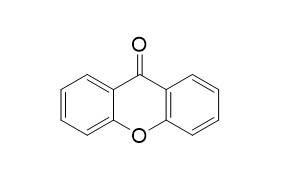Xanthone
Xanthone has antioxidant and anticorrosive properties, it performed excellently as a corrosion inhibitor for mild steel in sulphuric acid solution.
Inquire / Order:
manager@chemfaces.com
Technical Inquiries:
service@chemfaces.com
Tel:
+86-27-84237783
Fax:
+86-27-84254680
Address:
1 Building, No. 83, CheCheng Rd., Wuhan Economic and Technological Development Zone, Wuhan, Hubei 430056, PRC
Providing storage is as stated on the product vial and the vial is kept tightly sealed, the product can be stored for up to
24 months(2-8C).
Wherever possible, you should prepare and use solutions on the same day. However, if you need to make up stock solutions in advance, we recommend that you store the solution as aliquots in tightly sealed vials at -20C. Generally, these will be useable for up to two weeks. Before use, and prior to opening the vial we recommend that you allow your product to equilibrate to room temperature for at least 1 hour.
Need more advice on solubility, usage and handling? Please email to: service@chemfaces.com
The packaging of the product may have turned upside down during transportation, resulting in the natural compounds adhering to the neck or cap of the vial. take the vial out of its packaging and gently shake to let the compounds fall to the bottom of the vial. for liquid products, centrifuge at 200-500 RPM to gather the liquid at the bottom of the vial. try to avoid loss or contamination during handling.
Food Chem.2017, 228:301-314
Int J Mol Sci.2024, 25(5):2799.
Molecules.2021, 26(2):E255.
Vet World.2023, 16(3):618-630.
Phytomedicine.2022, 100:154058.
Srinakharinwirot University2023, 2669.
Nutraceutical Research . 2021, 19(1),p90-105.
Sci Rep.2018, 8(1)
Plants (Basel).2021, 10(6):1119.
Food Funct.2022, D1FO03838A.
Related and Featured Products
Current Applied Physics, 2011, 11(3):382-392.
Anti-corrosive properties of xanthone on mild steel corrosion in sulphuric acid: Experimental and theoretical investigations[Reference:
WebLink]
METHODS AND RESULTS:
The anti-corrosive effect of Xanthone (XAN) on the corrosion of mild steel in 0.5 M H2SO4 has been studied by gravimetric and UV–visible spectrophotometric methods at 303–333 K. Results obtained revealed that XAN performed excellently as a corrosion inhibitor for mild steel in sulphuric acid solution. Inhibition efficiency increases with increase in concentration of XAN but decreases with rise in temperature which is suggestive of physical adsorption mechanism although chemisorption may also play a part. Dubinin–Radushkevich adsorption isotherm model was found to adequately describe the adsorption of XAN onto the mild steel surface. Kinetic parameters of activation and thermodynamic parameters using the statistical model were calculated and discussed.
CONCLUSIONS:
The corrosion process in 0.5 M H2SO4 in the absence and presence of XAN follows first-order kinetics. The UV–visible absorption spectra of the solution containing the inhibitor after the immersion of mild steel specimen indicate the formation of a XAN–Fe complex. Quantum chemical calculations have been performed using DFT and several quantum chemical indices were calculated and correlated with the inhibitive effect.
J Agric Food Chem. 2009 Oct 14;57(19):8788-92
Bioavailability and antioxidant effects of a xanthone-rich Mangosteen (Garcinia mangostana) product in humans.[Pubmed:
19807152 ]
Oxidative damage is involved in many chronic diseases including those cited as the major causes of death in Western societies such as cardiovascular disorders and cancer. Antioxidants may prevent these degenerative processes by various mechanisms including the scavenging of free radicals. Intake of antioxidant supplements is associated with preventing oxidative damages.
METHODS AND RESULTS:
This study investigated the absorption and antioxidant effects of a Xanthone-rich mangosteen liquid in healthy human volunteers after the acute consumption of 59 mL of the supplement. The liquid contained mangosteen, aloe vera, green tea, and multivitamins. Results indicated that alpha-mangostin and vitamins B(2) and B(5) were bioavailable, with observed C(max) at t(max) of around 1 h. The antioxidant capacity measured with the oxygen radical absorbance capacity (ORAC) assay was increased with a maximum effect of 18% after 2 h, and the increased antioxidant level lasted at least 4 h.
CONCLUSIONS:
Overall, this study demonstrated the bioavailability of antioxidants from a Xanthone-rich mangosteen product and its in vivo antioxidant effects.
Revue Canadienne De Chimie, 1963, 41(2):522-526.
Cook D . INFRARED SPECTRA OF XANTHONE: LEWIS ACID COMPLEXES.[Reference:
WebLink]
METHODS AND RESULTS:
Xanthone, a member of the γ-pyrone species, which have basic carbonyl groups, forms an excellent series of solid complexes with Lewis acids. In these complexes the carbonyl oxygen atom is the donor site, and the carbonyl stretching vibration moves to progressively lower frequency as the Lewis acid strength increases. The carbonyl frequency in the BI3 complex, 1400 cm−1, is one of the lowest encountered in complexes of this type.
CONCLUSIONS:
The wide range of Lewis acids used to form these complexes has enabled a quantitative estimate of the Lewis acid strength to be made, which compares reasonably well with previous estimates.



